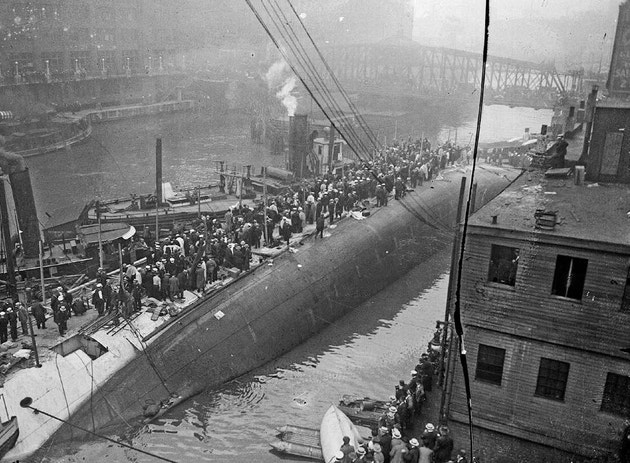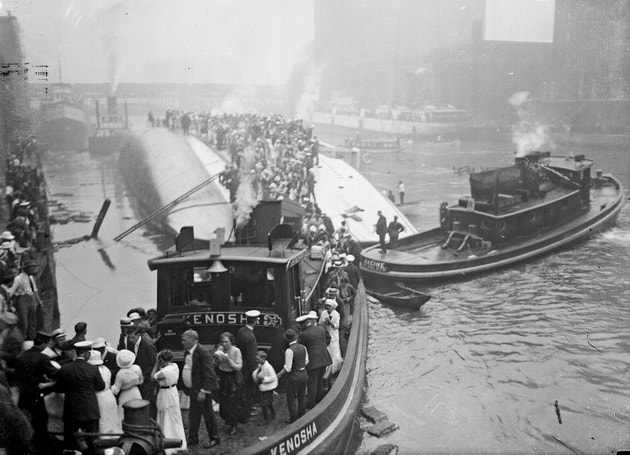A Tragic Summer Day
July 24, 2015

In Chicago, on July 24, 1915, nearly 850 people died after the luxury tour boat Eastland overturned in the Chicago River. In this image, survivors and rescuers stand on the hull of the overturned steamship. Chicago Daily News/Chicago Historical Society/Library of Congress
Today marks the 100th anniversary of a maritime tragedy, the Eastland disaster. People have heard of the sinking of the Lusitania, which happened in May 1915 and left 1,201 dead. They are still more familiar with the sinking of the Titanic in 1912, which killed an estimated 1,500 people. But the Eastland, which capsized while still tied to the dock, in shallow water some 20 feet (6 meters) from the bank of the Chicago River, killed nearly 850 people and is largely forgotten.
The Western Electric Company had chartered five Great Lakes ships, including the Eastland. The ships were to take Western Electric workers from downtown Chicago to Michigan City, Indiana, for the annual company picnic. The thousands of workers who made telephones for this company were poor, many of them were recent immigrants, and this event was the highlight of their year.
The Eastland had been launched in 1903 and was originally meant to carry 500 passengers in addition to goods. It had been refitted several times to hold more passengers, and on the morning of July 24, some 2,500 people boarded the Eastland and were waiting for it to set out. The ship had had problems before with listing (tilting to one side or another). The ship was top-heavy, and crew members kept it upright when in port by filling tanks in the ship’s hull with water for ballast. On July 24, the Eastland was carrying its maximum capacity of passengers. A large number of people were crowded onto the open upper decks. It was chilly and raining on that day, however, so many women with small children headed below deck to get out of the weather.
The ship began to list. Crew members struggled to fill tanks and right the ship, but it suddenly capsized. Safety measures put into effect after the sinking of the Titanic may have actually caused the Eastland to be even more unstable. The weight of so many life boats on the upper decks only made the ship more top heavy.
With the sudden capsizing, some people on the upper decks were thrown into the water and saved. Others on the upper decks were able to stay upright and walk on the ship’s hull to safety. Many people in the rooms below deck were trapped, however, leading to a large number of children among the dead. Although nearby boats responded almost immediately in the crisis and passersby on the river tried to save victims as well, the total death count was huge.

Survivors of the Eastland disaster climb onto the tugboat Kenosha from the hull of the overturned Eastland. Chicago Daily News/Chicago Historical Society/Library of Congress
The poet Carl Sandburg worked as a journalist at the time of the Eastland disaster and covered the story. In his poem The Eastland (not published until 1993), he wrote:
Women and kids, wet hair and scared faces,
The coroner hauling truckloads of the dripping dead
To the Second Regiment armory where doctors waited
With useless pulmotors and the eight hundred motionless stiff
Lay ready for their relatives to pick them out on the floor
And take them home and call up the undertaker. . .


